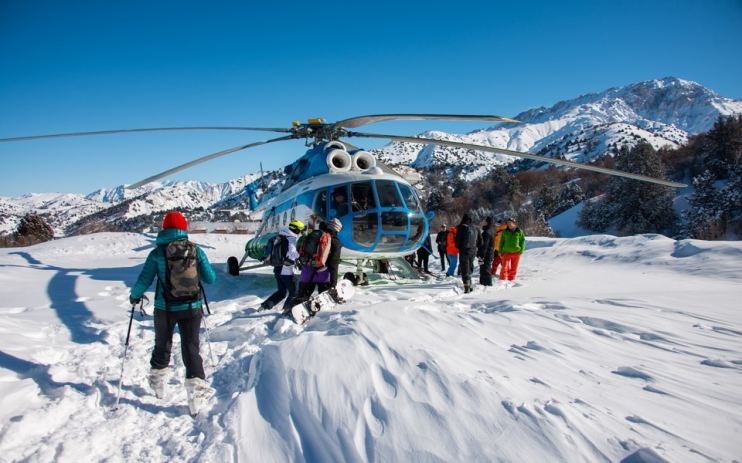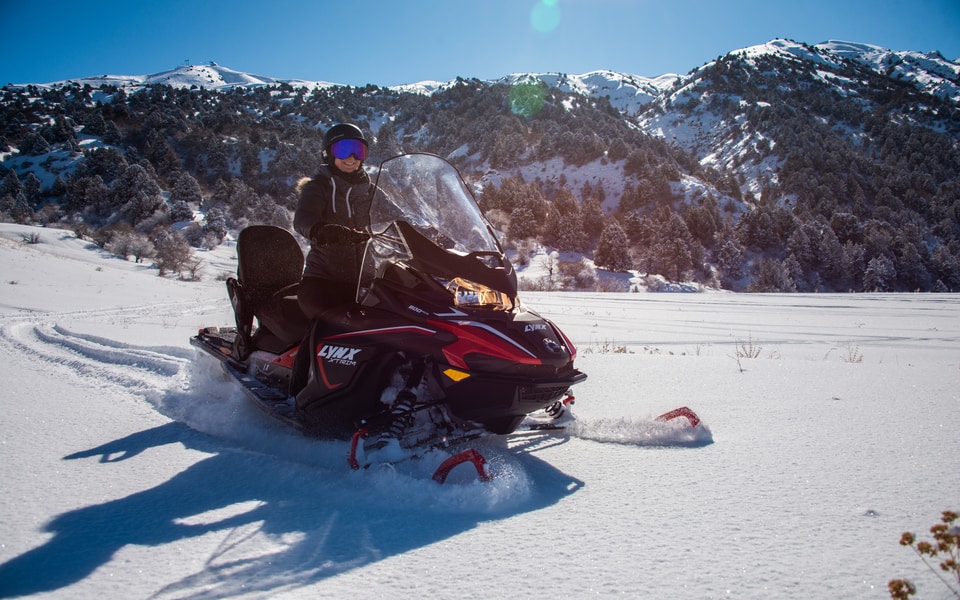Skiing in Uzbekistan, the cold heart of the Silk Road

I remembered the loudness of a helicopter, its blades beating the air like an incensed dragon. What I hadn’t realised, though, is that when a helicopter lands on deep snow, the force creates a blast of ice and powder which rips through your clothing and stings any inch of exposed skin. It goes on and on until the blades finally stop. All you can do is huddle close to the ground like a penguin.
Perhaps the experience elsewhere in the world isn’t this dramatic. But the current helicopter of choice for heli skiing in Uzbekistan is an ex military Mi8, a monster of a vehicle which would easily transport 16 troops with full kit. Anything that size will displace a lot of air and snow.

We bundled through the door on the helipad at Beldersoy, following diminutive ski guide Gregori Trebisovski and his colleague, Sergey Dolgiy. Gregori was the first heli ski guide in Uzbekistan, the first person to paraglide in the country, and a pioneer of free riding. He’s known in the extreme sports industry as “The Legend of Chimgan”, and rightly so. At 68 years old, he’s still on the mountain slopes every day of the season. There’s not a peak he hasn’t climbed, a ridge he hasn’t biked, or a back country route he hasn’t explored.
But even for Gregori, our flight was a first. In more than 20 years of heli skiing, he’d never before had a British group. The fact is that though the Russians and other hardcore skiers from the countries of the former Soviet Union knew that Uzbekistan has some of the best powder in the world, they kept the secret to themselves.
The cat finally got out of the bag this winter with the opening of the brand new Amirsoy Ski Resort in the Chimgan Mountains. The first part of a $1 billion investment programme in winter sports development in Uzbekistan, Amirsoy is being run by Andorra-based PGI Management. They’ve brought decades of expertise — plus more than 20 expat managers — to Uzbekistan to ensure the highest standards of health and safety and environmental practice.
Operations Director Thomas Thor-Jensen spent 12 years running Courchevel in France’s Three Valleys before moving to Amirsoy 18 months ago. Talking about the resort’s prospects he grows increasingly animated: “The snow is very dry, and even if it is warm in the day it stays light and dry. Normally you only get that at high altitude. The snow here is better than Japan. It’s the best snow I’ve seen anywhere in the world… We opened on 21 Dec and every day the number of skiers has increased.”

Amirsoy’s opening has given a huge boost to the heli skiing operation, too, even though its range is far beyond the extremities of the resort. Gregori estimates that this season he’s already hosted three times more skiers than he did in 2019. Uzbekistan Airways (owner of the Mi8) have also recognised the activity’s growth potential, and in February ordered five brand new helicopters from Airbus, to be delivered later this year.
Back to the belly of the beast, however. And “beast” is the right word: the Mi8 is big enough to stand up in, and so stable that you can slide open the side windows in flight and stick out your head (though watch out for your contact lenses). It’s pretty much a flying bus.
We had perfect flying weather, the snow blanketed peaks set against a vivid blue sky, with not a single cloud to be seen. Gregori guided the pilot to land at Ikhnach, 3,800m above sea level. If you’re thinking that sounds low, you’re right: Mont Blanc is 4,808m. But that’s one of the curious things about the powder here in the Chimgan Mountains. It manages to fall thick and fluffy even in the lower valleys.
The helicopter can’t loiter long on the mountain top; there’s a brief flurry of activity as the skiers are ejected, and then the helicopter was once again in the air. No two descents will be the same: one guide leads the way, choosing the optimum route for the conditions, and the rest of the group follows on in single file. In the Chimgan Mountains, the peaks aren’t steep, and the snow is so deep that rocks are generally well buried. We were far above the tree line, so obstacles were minimal.
Nothing beats the thrill of racing over untouched powder. Beyond our group, there wasn’t another person for miles. Even the birds were few and far between. The mountains seemed to stretch out forever in every direction, and unlike in the Alps the landscape rolls: there are no walls of ice and rock obscuring the view.
The pick up point for the run was on a frozen lake at around 2,500m. The helicopter was waiting. Even here, the snow was metres thick on the ground. It was too dry for snowballs, but perfect for diving headfirst into from the side of the helicopter. With glorious sunshine drenching the mountain bowl, and sheltered from the wind, we played like children, laughing elatedly, before taking to the skies again.
By the end of the day I was exhausted, ready to collapse in a heap. But the members of the Meteorological Society of Uzbekistan, away on a team building weekend, had other things in mind. Apres ski in Uzbekistan may be in its infancy, but traditions of hospitality date back to the times of the Silk Road. Our parties merged, bottles of vodka appeared, and I lost track of the number of toasts we drank. We drank to our hosts, and to Anglo-Uzbek friendship. We drank to women, to the President, the mountains, and the snow. I also toasted the future, as without doubt Uzbekistan’s winter sports tourism industry is on the cusp of a boom.
Asia Adventures (www.centralasia-adventures.com) offers a one week heli skiing package in Uzbekistan from £3,525pp. Return flights from London to Tashkent with Uzbekistan Airways (www.uzairways.com) start from £430 return.